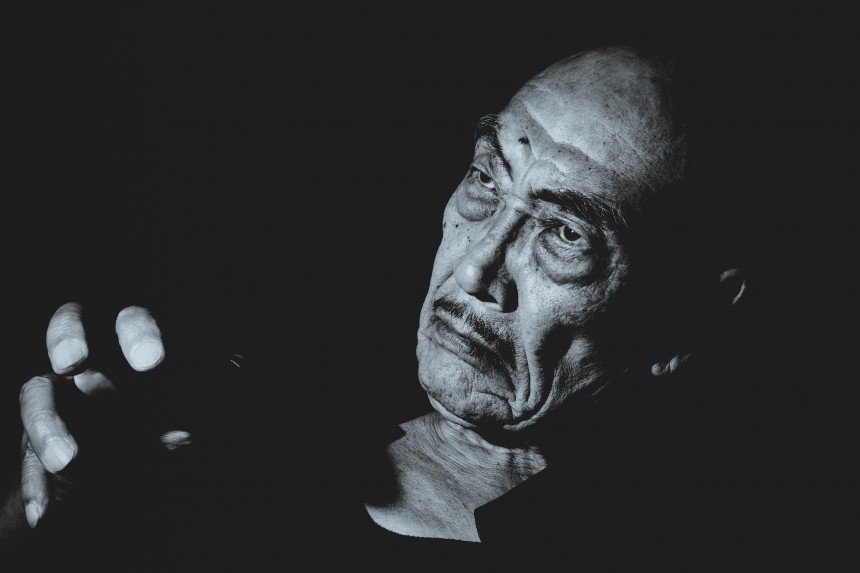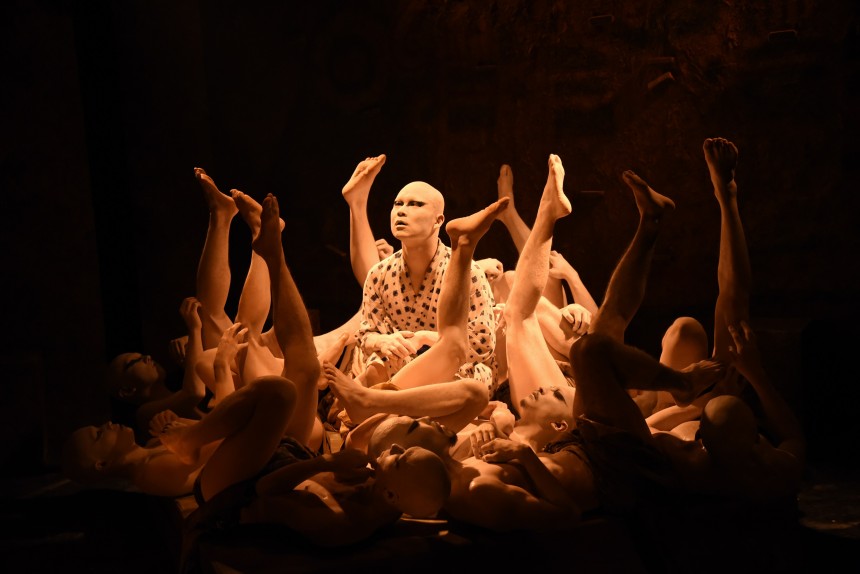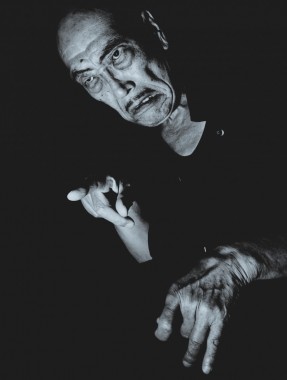
August 31, 2018
The Master: Akaji Maro
Metropolis interviews Japan’s most acclaimed butoh actor and director
By Paul McInnes
Born in Nara Prefecture in 1943 Akaji Maro was instrumental in Japan’s underground theater scene in the 1960s. He studied under and worked along side butoh founder Tatsumi Hijikata before establishing Dairakudakan Temputenshiki in 1972. Butoh, a grotesque and extreme form of dance and movement, was created in 1959, from the metaphorical ashes of the war as a reaction against Japanese dance of the time which mimicked Western and traditional Japanese techniques. Often performed in white body makeup with loincloths, butoh explores the darkness and desires of humanity alongside taboo topics which still shock some audiences today.
The Kichijoji-based Dairakudakan has become the world’s leading butoh troupe playing to audiences the world over and attracting critical acclaim wherever it performs. Dairakudakan’s style is a visually arresting hybrid between dance, theater and butoh. Akaji Maro, 75, still leads Dairakudakan in addition to appearing in TV dramas and films such as Quentin Tarantino’s Kill Bill.
Metropolis: Why did you establish Dairakudakan?
Akaji Maro: In the 1960s my seniors involved in the arts scene were trying to come up with new art forms. They were creating changes in the fields of music and drama and what not. For me I felt that all that could be done had probably already been done. The common issues for anyone doing avant-garde was trying to do something which hadn’t been done before. So what I did was create my own team, which became Dairakudakan. I decided not to pursue either dance or theater purely as itself. I tried to combine the two — a kind of synthesis or hybrid, if you like — and that is temputenshiki. That’s our ritualistic style of performance, but it’s different from rituals you see in shrines and temples because I try to ritualize the everyday, common things rather than special events.

M: How would you describe a Dairakudakan performance?
AM: The tricky thing with language is the more you explain the less you understand. It’s linguistically impossible, but physically possible to explain with your own physical body. Existence precedes language, which is secondary. Language can give motivation to move the body. Other people don’t perceive things in the same way. People peek into the performance with their own eyes and perceptions. You can write or talk about what you saw. By peeking into it and picking certain parts apart you can connect these observations to create your own drama and an idea of what the art actually is. I like to use the example of Dairakudakan as the falling apple in Newton’s story. The apple itself doesn’t know it’s falling. It doesn’t perceive itself. When Newton sees it he finds gravity but when a local peasant sees it he sees a waste of perfectly good food. So basically we’re the apple — the human body as an object for other people to interpret. The artwork is in your mind, not on the stage.
M: What’s the process like from the beginnings of an idea to an actual Dairakudakan performance?

AM: Rehearsals start two months before the performances. And before that, during the planning period, it really depends on the person. Especially because the younger performers also plan their own shows. For me, it’s usually one year or so before. I have a vague idea or buzzing in my head and I slowly develop that and try to figure out how to perform it. We usually work on the body first then add the music later. The music sometimes crashes into the performance and shatters it. I choose the music which accompanies or contrasts with the dance. We have a lighting specialist who also works with us.
M: Tell me about the Dairakudakan’s butoh summer camp.
AM: Originally it was just for Dairakudakan members. It began as a summer retreat. Then we started to bring in outside participants in 2002, people from Japan and all over the world, from 16-year-olds to people in their 60s and 70s. It’s a very diverse group. There are people who haven’t danced before, masterclass level performers who have put on shows worldwide, people who have gone to drama school and people with no experience at all. For those with theater experience, it doesn’t really apply at our summer school. There is no use for techniques and skills learned in theater schools. For the young participants who are 16, I tell them that their 16 years of life is a form of dance, it’s a source of dance.
We put them together as a group and then they give a performance at the end of the summer camp with a real audience. They use a routine which has been taught to them. There are many reasons why we do the camp. It’s to communicate with the outside world and to rethink and reevaluate our relationship with nature. There is the sky and the earth and, as a direct connection between them, we have human beings standing in the middle. It’s to reevaluate our position on earth, in contrast to the sky above us and the land below. To pass that kind of knowledge on is another reason for the camp.
M: What was it like working with Tatsumi Hijikata (founder of butoh)? What did you learn from him?

AM: Hijikata was a unique presence but he was a tricky person to be around. One of the things I learned from Hijikata was that dance isn’t about a system or method. Rather, dance is anywhere and everywhere. With Hijikata, I didn’t learn any specific dancing techniques in the three years I spent with him, but I took some of the techniques along the way. I remember when Hijikata and Kazuo Ohno were practicing at night, with a candle in the middle of the darkness, doing something that looked suspicious, like a ritualistic act. I looked at that and found it strange, but it drew me into this strange world. So I didn’t learn any methods of dancing or a systemized method, but I was drawn into the ritualistic act of dance.
Our dances are not the same, being that we had different backgrounds connected to different eras and different locations. For example, Hijikata would source from an Akita farmer or an environment from 100 years ago. That’s where he would draw inspiration. And Ohno also had his specific style. So there are differences that come out of what background you carry with you. And that’s what I learned. So I asked myself what’s the background that I should carry with me? And what background should inform my performance? And that background is unique to my performances when compared to Hijikata or Ohno. That is something you don’t learn from a systemized technique. In that sense it’s similar to noh. Noh isn’t about specific techniques but also a reflection of background.
M: One of the meanings of butoh is “dance of darkness.” Does it have any other meanings?
AM: I understand why it’s called the dance of darkness. The darkness not being a literal darkness but rather the subconscious; the darkness of your background. It’s something you don’t see until you bring forth that darkness into performance. My style fits into that. There are also subdivisions within that which also brings forth the subconscious. One is the shamanistic side. For example, in Japan there are festivals in places like Akita and other rural locations where you have performances that contain dialogue with the gods. These commoner festivals sprout from the overall category of darkness. It’s not only the darkness of our background, it could be hidden desires or hidden needs — to bring that to light, to perform that is the meaning of darkness and the meaning of butoh.
M: Are Dairakudakan performances focused on the physical or on a reflection of society?
AM: The two can’t be separated between the body and the world that constructs the body. I don’t try to show something that I want to present to the audience. It’s a form of voyeurism. People can look at it and have their own interpretation through the safety of their own eyes. If people want to look at it in a political sense they can, religious they can, philosophical they can. If it’s a local old lady then she probably has her own interpretation. So it’s pretty much up to them. They can see things through their own lens.
M: After Dairakudakan shows at your studio in Kichijoji actors often mingle outside with the audience sharing drinks and cigarettes and chatting. Is it important to break down the barrier between performers and audience?
AM: I haven’t really thought about that before. It’s not something we do on purpose. I can’t just say goodbye to friends after the show and then go back inside. I’d rather say thanks to them and have a chat outside. It must be funny, however, to see some strange guy in white makeup standing in the street talking to someone but it’s not on purpose. It happens naturally.

M: You recently staged Crime and Punishment at the New National Theatre, Tokyo (NNTT). What was it like working in such a large space compared to your own smaller studio space?
AM: There are some differences. For example, how people see the smaller movements or slight changes in facial expressions. In that sense it’s definitely easier to observe the human body when people are closer to the stage. In bigger spaces, like the NNTT, if you want to look closely you’d have to use opera glasses in which case you can’t see the whole stage, only part. But what we do on stage isn’t that different. We might exaggerate some movements but other than that there’s not much difference. There are plenty of examples of us transferring performances from here to a larger space and vice versa.
M: You act on TV and in films. What’s the difference between them and butoh performance?
AM: The big difference between film/TV and butoh is with butoh it’s the peeking, the lens you see the performance through. There’s no clear message that’s being told. With TV or film there are words and communication, proper communication that’s established. Of course there are some exceptions, but in most cases there is storytelling. I’m involved in storytelling and I can’t stray too far from it. I like working in TV and film because I’m not buried by a sense of responsibility. I can be passive and ask the director what I should do and follow directions. I can be irresponsible and that’s a load off my back. What I bring to TV and film from butoh is the way I express emotions. But to be honest, often the expressions from butoh are too exaggerated for movies. In TV and film I’m expected to be ordinary characters who don’t over exaggerate their emotions.
M: You played Boss Ohzawa in Kill Bill. What was it like working with Quentin Tarantino?

AM: Tarantino studied Japan very well. I would be told, for example, to act in a similar way as a specific scene in a specific movie, which many people hadn’t actually heard of and that was interesting. Tarantino likes Toei films and he’s really into the Toei style, traditional Japanese-themed films. Even in terms of yakuza films he would reference Toei ones, not necessarily the modernized, cooler yakuza films. Tarantino is really good at praising people. I’d be told subarashi (fantastic). He would tell me that I was better than De Niro or Al Pacino in terms of acting. But in the back of my mind I’d think — then I want to be paid the same as them! Tarantino is a really fun character to be with and really good at praising, but sometimes he’d go a little far, so what he’d say wouldn’t be believable. He’s still fun to be with on set.
M: You are 75 now. Have you thought of retiring? Or will you perform until your last breath like Kazuo Ohno?
AM: I won’t retire. I’ll probably die on stage. For me, being a corpse is one form of dance. I don’t want to retire as I don’t want to become a kind of criminal. If I can’t perform then I may do something crazy like kill someone. Or randomly shoot people or storm the National Diet. It’s a form of keeping the gun at bay. Ohno is someone I look up to. Not necessarily inspired by him, but he’s like my north star. Ohno died with the music and performance. But I’d rather infuse some technology into my death — the final curtain. Like being electrocuted!
M: Why do we, human beings, dance or perform?
AM: To make amends or compromise with the secret of existence. The irrationality of human existence—the fact that we live and exist is hard — it’s kind of like existentialism. Something similar would be mythology. A lot of communities all over the world have mythologies about gods and why they and we exist. Performance and dance and other art forms are similar. To make amends with the irrationality of existence and how to overcome that and the secret of why we exist and why we are who we are.








